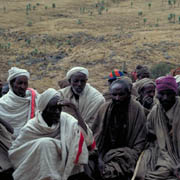The road for entrepreneurship in African World Heritage sites
The African World Heritage Fund celebrates the year of entrepreneurship and business skills in 2014, a new theme to help focus efforts on boosting community involvement in World Heritage conservation.
As we replace old calendars with fresh ones, the New Year offers a time to pause, reflect and look ahead. For the African World Heritage Fund, 2014 marks the year of entrepreneurship and business skills. With it comes the opportunity to raise awareness and stimulate action around this theme, following a series of activities around risk preparedness in 2013.
The African World Heritage Fund, founded in 2006, provides training and financial support to strengthen capacity and achieve better conservation of Africa’s natural and cultural heritage. It works in collaboration with UNESCO, IUCN and ICCROM. For the year to come, it has set out to put into action a plan focussing on issues related to business activity surrounding World Heritage sites.
“World Heritage is about protection of the site, but it also brings economic benefits due to tourism for example,” says Souayibou Varissou, Head of Programmes at African World Heritage Fund. “Of course, there has to be a balance between protection and business opportunity. Communities need adequate business skills to benefit from the opportunities arising out of World Heritage sites and build sustainable activities as entrepreneurs.”
The implementation of the action plan will pan across several activities. Firstly, training will be provided to help potential entrepreneurs understand risks and recognize obstacles. Secondly, field projects will take place to identify potential issues and evaluate needs that could translate into business opportunities. Finally, research will be conducted on World Heritage and business activity so that lessons learnt can help future projects.
So how do you reconcile business with World Heritage values? “That is a good question, but a difficult one – particularly in the context of natural World Heritage,” says Souayibou Varissou. “The issue is more straight-forward for cultural heritage, because cultural heritage sites already imply human interference. But we can get a good idea of how this can work in practice for nature by looking at cultural landscapes.”
Cultural landscapes are defined as outstanding examples of the combined works of nature and man under the UNESCO World Heritage Convention. They not only show how humankind interacts with the natural landscape, but also a level of interdependence that develops to the benefit of both nature and humans.
“The presence of indigenous communities in certain sites creates unique types of traditional management systems of the surrounding environment,” explains Souayibou Varissou. “Ancestral knowledge is passed on from generation to generation, perpetuating a particular know-how that helps for the conservation of a particular site, which otherwise may not have been protected.”
Varissou quotes the Sacred Mijikenda Kaya Forests as an example. The cultural site in Kenya consists of 11 forest sites containing the remains of fortified villages (or kayas), which are now revered and maintained by elders as sacred sites. The rules they imposed to access and use of natural resources have allowed biodiversity to remain largely intact.
This extraordinary site is an inspiring example of how the environment can benefit from man. But in the case of natural sites, more often than not the reality shows that human activity is a threat to nature. In the most deprived parts of Africa, it is difficult to prevent local communities from using natural resources provided by biodiversity-rich protected areas to sustain their livelihoods. In turn, this can result in cases of land encroachment, illegal logging, fire or wildlife trade.
In the context of World Heritage, where the highest level of protection is expected, human settlement is unfortunately usually viewed as incompatible with nature conservation. Consequently, the protection of a natural World Heritage site can sometimes engender the delocalization of people.
According to Souayibou Varissou, the most important aspect of this problem is that people need to find alternatives to their livelihoods. This is why it is important to offer them the opportunity to acquire the necessary business skills to develop activities that are compatible with the integrity of World Heritage sites.
“We need to convince people that participating to the conservation of natural World Heritage brings benefits. To do this, we need to show them how to achieve this concretely, for example by becoming a park guide or developing ecotourism activities,” he says. “2014 is the year where we will start giving tangible support to communities so they can learn how to benefit from World Heritage site while helping to conserve them in a sustainable way.”
For more information visit the African World Heritage Fund or contact SouayibouV@awhf.net.





